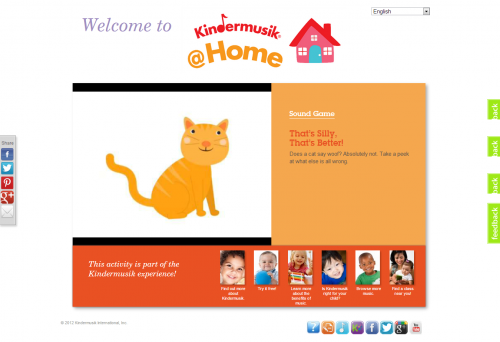Digital Learning in the Early Childhood Classroom and at Home!

Have you seen the video of the one-year-old child interacting with her father’s iPad and then a print magazine? After touching the tablet screen to make images increase in size, she tried doing the same thing to pictures in a magazine. Of course, that didn’t quite work!
Most children today will never remember a time before the Internet, smart phones, and tablets. Not to mention, with 30 percent (and rising!) of today’s college students taking at least one online class, higher education will look quite different for our children.
Digital Learning and Early Childhood
Children engage in digital learning from an early age. Even the youngest child can model the actions of a parent talking on a smart phone or reading an eBook. A recent report, Take a Giant Step: A Blueprint for Teaching Children in a Digital Age, published by the Digital Age Teacher Preparation Council, includes strategies and tactics to better equip preschool and elementary teachers to provide age-appropriate digital learning opportunities for young children.
“Teaching young children today demands a new approach to an exciting but increasingly complex set of challenges,” said Linda Darling-Hammond in a press release. “Quality early learning programmes in our digital age will be led by highly prepared, flexible teachers who can effectively integrate what they know about healthy child development with the resources of an always connected, thoroughly modern environment.”
The report highlights the understanding that integrating digital learning into early childhood works best when it enhances children’s engagement, such as talking, interacting, manipulating, pretending, reading, constructing, and exploring. (Sounds like a Kindermusik class to us!) In order to help early childhood educators best capture the power of digital learning, the report outlined several goals to accomplish by 2020:
- Advance technology integration and infrastructure
- Modernize professional learning programmes and models
- Expand public media use as a cost-effective asset for teachers
- Create a Digital Teacher Corps
Digital Learning:
Making Connections between the Classroom and Home
In one early childhood digital learning study featured in the report, researchers worked with a Reception teacher and her five- and six-year-old students. The researchers loaded math activities, video clips, and digital worksheets onto tablet computers. The tablets also included material for parents on the goals of the activities and information on the math topics and keywords the students learned at school. For homework, each student received a tablet to take home for four weeks.
After the four weeks ended, parents said that they felt more connected to what was happening in the classroom and were better able to offer their children help because they knew exactly what they were working on and what concepts they should understand. Plus, children spent more time on their homework and improved mathematics skills.
Digital Learning and eBooks with Kindermusik@Home

After more than 30 years of developing early childhood curricula, including music classes for toddlers, babies, big kids, and families, we understand that the days may pass slowly but the years fly (or dance) by. One day a baby may be taking her first steps in a Cuddle & Bounce class and seemingly the next day she is walking across the stage to receive a secondary school diploma. Wow. Talk about a fast dance.
We know that music can impact a young child in profound ways and can set a child up for early academic success. We also know, as the above report showed, how important technology fluency will be to your child, which is one of the reasons we created Kindermusik@Home. With Kindermusik@Home, families can engage in age-appropriate digital learning, such as virtual field trips and active listening games, read eBooks, and download all the music from class. Kindermusik@Home connects the classroom learning with a family’s everyday life, making the learning (and fun!) last throughout!
